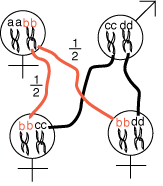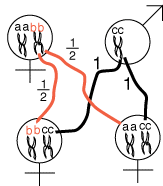

Back to 4. Levels of Selection
 |
Under mechanisms of diploid sex determination the probability that sibs will get the same copy of an allele is given by the probability of picking a specific allele (e.g., b) twice or 1/2 * 1/2 = 1/4. There are two possible ways in which this can happen from any given parent (each parent has two alleles) so we derive the probability of sharing alleles to be 2*1/2*1/2 = 1/2 from a specific parent. Each parent contributes half the genetic material to progeny so the probability of any gene being identical is 1/2*1/2 = 1/4 for any one parent. However, progeny have two parents so we multiply this by 2 to get the probability that sibs share alleles: 2*1/4 = 1/2. (see Side Box 2.4 for a second derivation of this same quantity.) |
 |
Under mechanisms of haplodiploid sex determination each offspring gets identical copies of half of their genes from their father so they share 1*1/2 =1/2 of their alleles from their father's side. They share the usual 1/4 from the maternal side (see above). The total frequency of shared alleles is 1/2+1/4=3/4. Thus, the coefficient of relatedness for sibs under haplodiploidy is substantially higher than it is under normal diploid sex determination. |